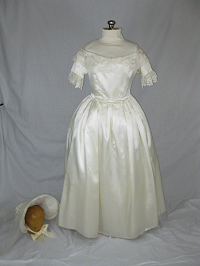1840s
In the 1840s the favorite colors were plum, gold, olive. Two gowns in the Cincinnati Museum of Art were used to recreate this new gown in off white satin. At this time, women would play the part of lovely porcelain dolls as an escape from the harshness of reality. Clothing fashioners went to extremes in creating this demure and fragile look. All things feminine, delicacy, smallness, frailty, beauty were sought after, and fashion was the vehicle for achievement. Writers talked about an inner light but along with the religious fervor came coquettish behavior. The large brimmed bonnets were said to be used to hide from the stray glances of a beau or to flirt, whichever a young lady wished. Veils, in use from early in the century, now hang from the brim or crown of the bonnet to be drawn over the face or tied under the chin.
The bodice is always lined and boned. A number of these bodices were found to have pads of wool attached in front to supplement the deficiencies of anatomy, a device specially in use the first half of the 1840s before the “artificial bust improver” was invented. It was the fashion to be willowy, and young ladies assiduously practiced slimming so they might be able to display an 18-inch waist. They also began to use dress protectors of india rubber or chamois leather, sewn into the dress. The skirt, except for summer, was lined either with silesia (a twill cotton lining fabric) or for eveningwear with the same thin cotton muslin used for book covers at the time. Winter dresses were frequently lined with flannel between the cotton and the dress material. In this dress, the skirt is of three-and-a-half yards of fabric, tightly pleated in the back.
Underneath the dress were several layers, which gave a bouffant airy appearance. Watches were worn on long chains, and many women’s outfits included a small watch pockets placed in waistline.
Click photo for detailed view.


